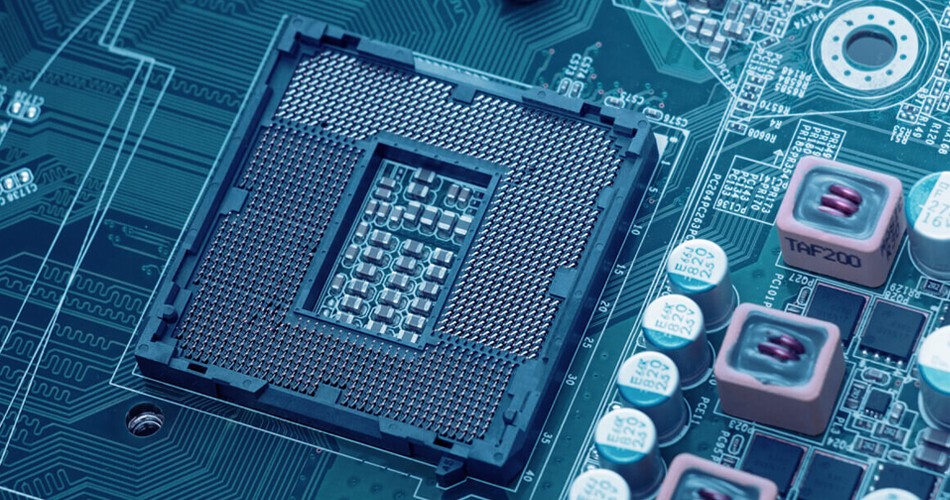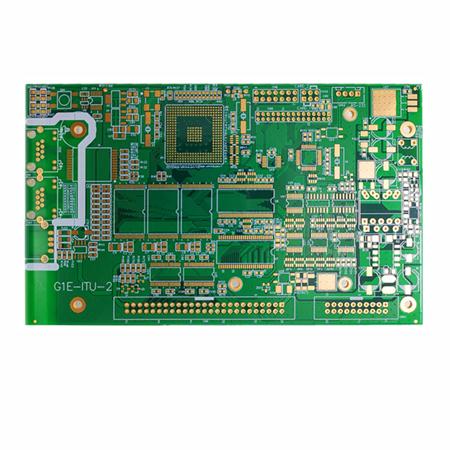
Circuit board manufacturer explains basic knowledge of electronic circuit and summarizes essence version
Fundamentals of Circuits
Voltage and current
The reference direction of current can be arbitrarily specified. During analysis: if the reference direction is consistent with the actual direction, i>0, otherwise, i0.
The reference direction of voltage can also be arbitrarily specified. During analysis, if the reference direction is consistent with the actual direction, then u>0 and vice versa.
Power Balance In a real circuit, the power from the power supply is always equal to the power consumed by the load.
Ohm's law of the whole circuit U=E-RI
The meaning of load size The greater the current of the circuit, the greater the load. The greater the resistance of the circuit, the less the load.
Open circuit and short circuit The open circuit of the circuit: I=0, U ≠ 0 The short circuit of the circuit: U=0, I ≠ 0.

2. Kirchhoff's law
Several concepts of Kirchhoff's law:
Branch: a branch of a circuit.
Node: The connection point of three (or more) branches is called a node.
Loop: A closed path composed of branches is called a loop.
Mesh: The circuit without other branches passing through is called mesh.
Kirchhoff's current law:
Definition: At any time, the algebraic sum of current flowing into a node is zero. In other words, the incoming current is equal to the outgoing current.
Expression: sum of i input=0 or: i input=i output.
It can be generalized to a closed surface.
Kirchhoff's voltage law defines that the rise of voltage is equal to the fall of voltage through any closed path. In other words, in a closed circuit, the algebraic sum of voltages is zero. In other words: in a closed circuit, the sum of the voltage drops on the resistance is equal to the sum of the electromotive force of the power supply.
3. Concept of potential
Definition: The potential of a point is equal to the voltage from the point to the circuit reference point.
It is specified that the potential of the reference point is zero. It is called grounding.
The voltage is represented by the symbol U, and the potential is represented by the symbol V
The voltage between two points is equal to the difference of potential between two points.
Pay attention to the simplified drawing of power supply.
4. Ideal voltage source and ideal current source
Ideal voltage source
The output voltage of the ideal voltage source remains unchanged regardless of the load resistance and the output current. The output power of an ideal voltage source can reach infinity.
The ideal voltage source does not allow short circuits.
Series parallel connection of ideal power supply and resistance
The ideal voltage source is connected in parallel with the resistance, which can remove (disconnect) the resistance without affecting the analysis of other circuits.
The ideal current source is connected in series with the resistor, which can remove the resistor (short circuit) without affecting the analysis of other circuits.
5. Voltage source and current source in practical application
The actual voltage source can be represented by a series connection of an ideal voltage source and an internal resistor. The actual current source can be represented by a parallel connection of an ideal current source and an internal resistor.
The branch current method means that the branch current is used as an unknown quantity and the method of solving equations is as follows:
There are b branches in the circuit, and a total of b equations need to be listed.
If there are n nodes in the circuit, first use Kirchhoff current law to list n-1 current equations.
Then select b - (n-1) independent circuits, and use Kirchhoff voltage law to list the voltage equation of the circuit.
Note: If a branch of the circuit contains a current source, the current of the branch is known, and one equation can be omitted (the voltage equation of one loop is omitted).
6. Superposition principle
In a linear circuit, the voltage and current everywhere are the result of superposition of multiple power sources acting independently.
The solution method considers that when a power source acts alone, other power sources should be removed, and other voltage sources should be short circuited and current sources disconnected.
Note: When the problems are finally superimposed, the direction of the current generated by each power source and the total current should be considered. The superposition principle is only suitable for linear circuits, not for nonlinear circuits; It is only suitable for the calculation of voltage and current, not for the calculation of power.
7. Davining theorem
A complex two terminal network with a source is equivalent to a resistance and voltage source.
The method of equivalent supply voltage disconnects the load resistance and calculates the open circuit voltage UOC of the circuit. The equivalent supply voltage UeS is equal to the open circuit voltage UOC of the two terminal network.
8. A method for calculating the internal resistance of equivalent power supply
Disconnect the load resistance, remove the power supply in the two terminal network (voltage source short circuit, current source open circuit), and the resistance seen from both ends of the load is the internal resistance R0 of the equivalent power supply.
Disconnect the load resistance and calculate the open circuit voltage UOC of the circuit. Then, short-circuit the load resistance, calculate the short-circuit current ISC of the circuit, and the internal resistance of the equivalent power supply is equal to UOC/ISC.
9. Norton theorem
A complex two terminal network with a source is equivalent to a parallel circuit with a resistor and a current source.
The calculation of equivalent current source current IeS shortens the load resistance and calculates the short-circuit current ISC of the circuit. Then the current IeS of the equivalent current source is equal to the short-circuit current ISC of the circuit.
The internal resistance of the equivalent power source is the same as that in Davining's theorem.
10. Rerouting rule
Circuit changing principle: the voltage at both ends of the capacitor remains unchanged, Uc (o+)=Uc (o -). The current on the inductor remains unchanged, Ic (o+)=Ic (o -). The reason is that the energy storage of the capacitor is related to the voltage at both ends of the capacitor, and the energy storage of the inductor is related to the current passing through.
Treatment of inductance and capacitance during switching:
Before switching, Uc (o+)=0 when the capacitor has no energy storage. After switching, Uc (o -)=0, the voltage at both ends of the capacitor is equal to zero, and the capacitor can be regarded as a short circuit.
Before switching, Uc (o+)=U when the capacitor has energy storage. After switching, Uc (o -)=U, the voltage at both ends of the capacitor remains unchanged, and the capacitor can be regarded as a voltage source.
Before switching, IL (o -)=0 when the inductor has no energy storage. After switching, IL (o+)=0, the current passing through the inductor is zero, and the inductor can be regarded as an open circuit.
IL (o -)=I when the inductor has stored energy before switching. After switching, IL (o+)=I, the current on the inductor remains unchanged, and the inductor can be regarded as a current source. According to the above principles, the initial values of voltage and current in the circuit after switching can be calculated.
11. Basic concept of sine quantity
Three elements of sine quantity:
The quantity representing the size: valid value, maximum value.
The quantity representing the speed of change: period T, frequency f, angular frequency ω。
The quantity representing the initial state: phase, initial phase, phase difference.
Basic knowledge of plural:
The complex number can be used to represent a directed line segment. The module of the complex number A is r, and the argument is Ψ。
Expression of complex number: 1. algebraic expression; 2. Triangular type; 3. Exponential; 4. Polar coordinate.
The addition and subtraction of complex numbers are carried out in algebraic expressions, and the multiplication and division of complex numbers are carried out in exponential or polar coordinates.
The meaning of the imaginary unit j of the complex number: any vector multiplied by+j rotates forward (counterclockwise), and multiplied by - j rotates backward (clockwise).
Phasor representation of sinusoidal quantities:
The significance of phasor is to use the module of complex number to represent the magnitude of the sinusoidal quantity, and the radiance of complex number to represent the initial phase of the sinusoidal quantity. Phasor is a complex number used to represent the sine quantity. To distinguish from general complex numbers, a small dot is added to the symbol of phasor.
The maximum phasor represents the maximum value of the sinusoidal quantity with a complex modulus.
The RMS phasor uses the complex modulus to represent the RMS of the sinusoidal quantity.
Note that the sine quantity has three elements, while the complex number has only two. Therefore, the phasor only represents the size and initial phase of the sine quantity, not the cycle or frequency of the alternating current. Phasor is not equal to sine.
The Meaning of Using Phasor to Express Sine
After the sine is represented by phasors, the addition and subtraction, multiplication and division, integral and differential operations of the sine can be transformed into complex algebraic operations. The addition and subtraction of phasors can also be realized by graphical method, which is the same as the parallelogram method and triangle method of complex number operation.
12. Power of AC circuit
Instantaneous power: p=ui=UmIm · sin( ω t+ φ)· sin ω t=UIcos φ- UIcos(2 ω t+ φ)
Average power: P=UIcos φ Average power is also called active power, where cos φ It is called power factor. The active power in the circuit is the power consumed on the resistance.
Reactive power: Q=ULI-UCI=I2 (XL-XC)=UIsin φ The reactive power in the circuit is the power exchanged back and forth between the inductor, capacitor and power supply.
Apparent power: S=UIThe unit of apparent power is volt ampere (VA), which is commonly used to represent the capacity of power supply equipment such as generators and transformers.
Power triangle: P, Q and S form a triangle, where φ Is the impedance angle.
13. Power factor of circuit
Meaning of power factor Power factor is the proportion of the active power of the circuit to the total apparent power. The power factor can be seen from the power triangle. A high power factor means a large proportion of active power and a small proportion of reactive power in the circuit.
Reasons for low power factor:
Inductive load asynchronous motors are widely used in production and life. Washing machines, electric fans and fluorescent lamps are all inductive loads.
The motor operates with light load or no load (the horse pulls the trolley), and the asynchronous motor operates with no load cos φ= 0.2 ~ 0.3, cos at rated load φ= 0.7~0.9。
The significance of improving the power factor is that the shunt capacitors at both ends of the inductive load can compensate the reactive power consumed by the inductor and improve the power factor of the circuit.
Improve the utilization of power generation equipment and transformers: power supply equipment such as generators and transformers have a certain capacity, called apparent power. Increasing the power factor of the circuit can reduce the output of reactive power, increase the output of active power, and increase the utilization of equipment.
Reduce the loss of the line: When the power transmitted by the line is fixed and the transmission voltage of the line is fixed, increasing the power factor of the circuit can reduce the current of the line, thus reducing the power loss on the line, reducing the voltage drop on the line, improving the power supply quality, and using thinner wires can save construction costs.
The above is the basic electronic circuit knowledge that Shenzhen PCB design, PCB manufacturing, and PCB manufacturers explain to you.







